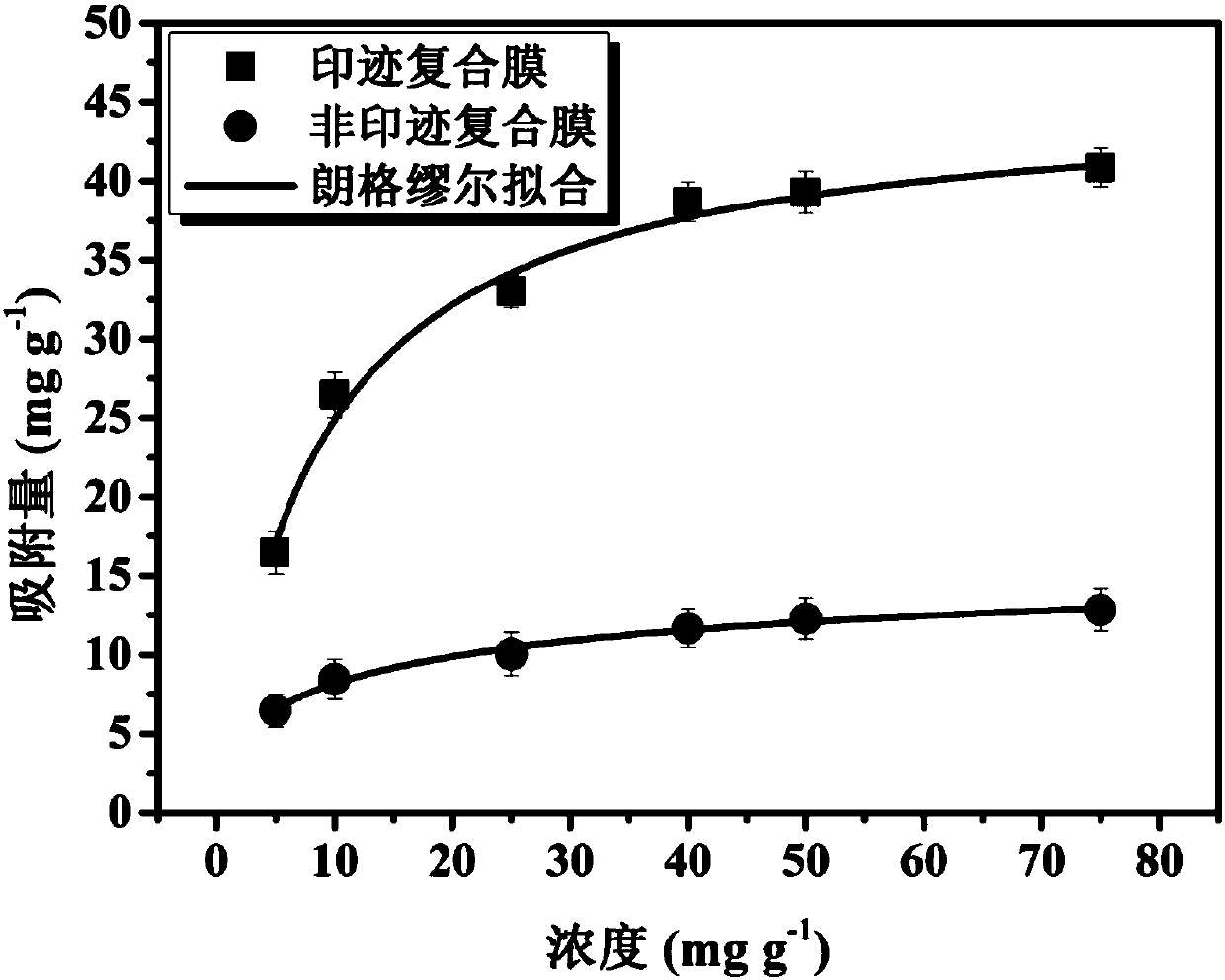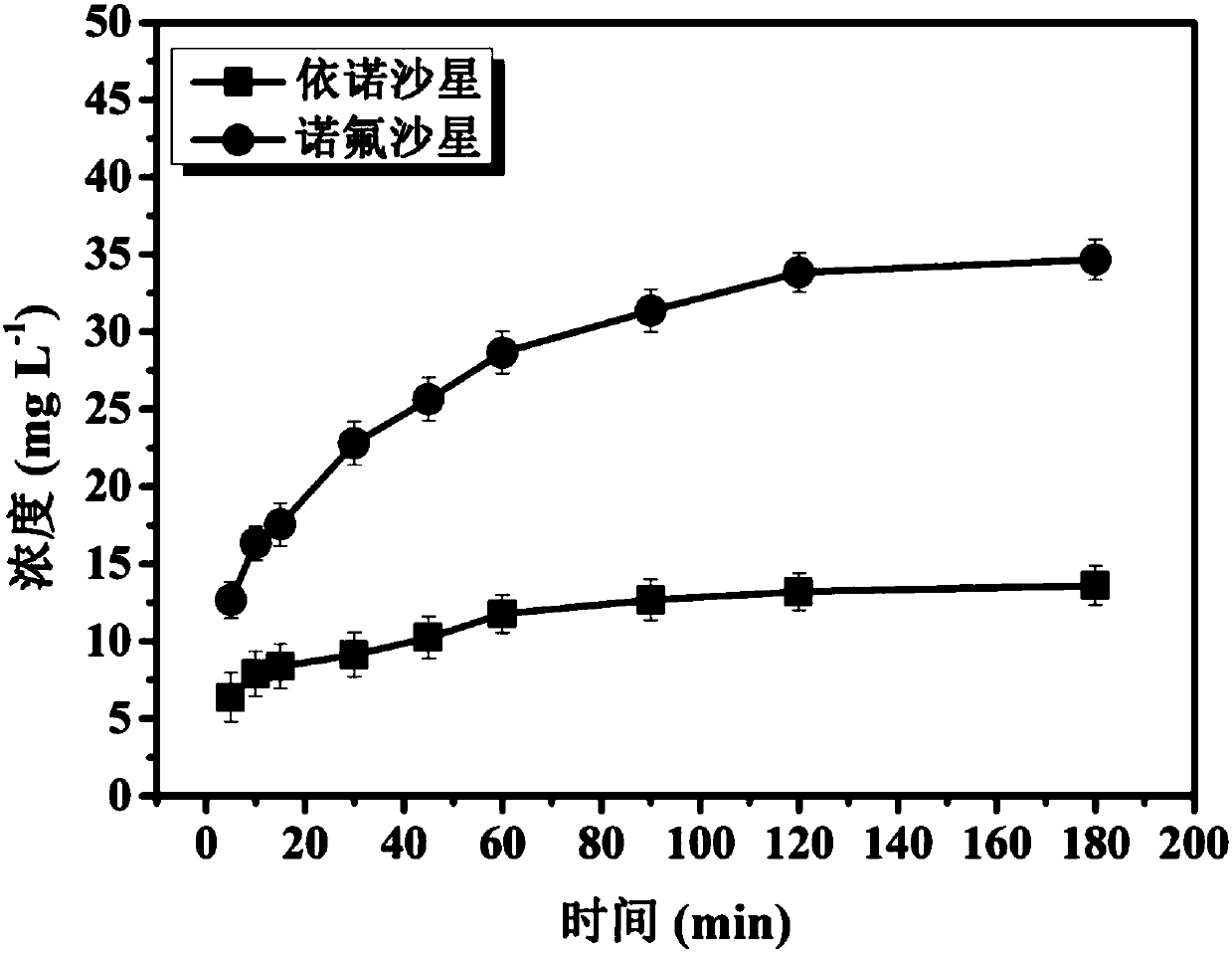Preparation method of molecularly imprinted composite membrane material for selective separation of enoxacin
A technology of molecular imprinting and enoxacin, which is applied in semipermeable membrane separation, chemical instruments and methods, membranes, etc., can solve the problems of low flux, low separation performance and selectivity, hydrophilicity and antifouling of molecular imprinted membranes Poor performance and other problems, to achieve the effect of more recognition sites, significant separation effect, and improved hydrophilicity
- Summary
- Abstract
- Description
- Claims
- Application Information
AI Technical Summary
Problems solved by technology
Method used
Image
Examples
Embodiment 1
[0044] S1. Preparation of carbon nanosphere (CNS) gel
[0045] After mixing phloroglucinol: terephthalaldehyde: deionized water with a ratio of 0.063g: 0.05g: 28mL, ultrasonic treatment to fully dissolve it, and mechanical stirring at 70°C for 30min to form a carbon nanosphere gel ; The resulting CNS gel is 4g / L, diluted with water to 50, 100, 200, 400 and 800mg / L for later use, for the subsequent film-making process, as a coagulation bath required during phase inversion.
[0046] S2. Preparation of carbon nanosphere grafted polyvinylidene fluoride film (CNS@PVDF)
[0047] First, put polyvinylidene fluoride powder: polyvinylpyrrolidone: N-methylpyrrolidone (NMP) with a ratio of 4g: 0.1g: 20mL into the flask and seal it, and keep stirring mechanically in a water bath at 60°C for 24 hours to form Uniform casting solution. Afterwards, vacuumize to remove the air bubbles in the casting solution. Then the casting solution was poured on the glass plate, and the film was scraped, ...
Embodiment 2
[0060] S1. Preparation of carbon nanosphere (CNS) gel
[0061] After mixing phloroglucinol: terephthalaldehyde: deionized water with a ratio of 0.063g: 0.05g: 28mL, ultrasonic treatment to fully dissolve it, and mechanical stirring at 70°C for 30min to form a carbon nanosphere gel ; The resulting CNS gel is 4g / L, diluted with water to 50, 100, 200, 400 and 800mg / L for later use, for the subsequent film-making process, as a coagulation bath required during phase inversion.
[0062] S2. Preparation of CNS@PVDF
[0063] First, put polyvinylidene fluoride powder: polyvinylpyrrolidone: N-methylpyrrolidone (NMP) with a ratio of 4g: 0.3g: 20mL into the flask and seal it, and keep stirring mechanically in a water bath at 60°C for 24 hours to form Uniform casting solution. Afterwards, vacuumize to remove the air bubbles in the casting solution. Then the casting solution was poured on the glass plate, and the film was scraped, and the glass plate covered with the casting solution was...
Embodiment 3
[0076] S1. Preparation of carbon nanosphere (CNS) gel
[0077] After mixing phloroglucinol: terephthalaldehyde: deionized water with a ratio of 0.063g: 0.05g: 28mL, ultrasonic treatment to fully dissolve it, and mechanical stirring at 70°C for 30min to form a carbon nanosphere gel ; The resulting CNS gel is 4g / L, diluted with water to 50, 100, 200, 400 and 800mg / L for later use, for the subsequent film-making process, as a coagulation bath required during phase inversion.
[0078] S2. Preparation of CNS@PVDF
[0079] First, put polyvinylidene fluoride powder: polyvinylpyrrolidone: N-methylpyrrolidone (NMP) with a ratio of 4g: 0.5g: 20mL into the flask and seal it, and keep stirring mechanically in a water bath at 60°C for 24 hours to form Uniform casting solution. Afterwards, vacuumize to remove the air bubbles in the casting solution. Then the casting solution was poured on the glass plate, and the film was scraped, and the glass plate covered with the casting solution was...
PUM
| Property | Measurement | Unit |
|---|---|---|
| adsorption capacity | aaaaa | aaaaa |
| adsorption capacity | aaaaa | aaaaa |
| adsorption capacity | aaaaa | aaaaa |
Abstract
Description
Claims
Application Information
 Login to View More
Login to View More - R&D
- Intellectual Property
- Life Sciences
- Materials
- Tech Scout
- Unparalleled Data Quality
- Higher Quality Content
- 60% Fewer Hallucinations
Browse by: Latest US Patents, China's latest patents, Technical Efficacy Thesaurus, Application Domain, Technology Topic, Popular Technical Reports.
© 2025 PatSnap. All rights reserved.Legal|Privacy policy|Modern Slavery Act Transparency Statement|Sitemap|About US| Contact US: help@patsnap.com


